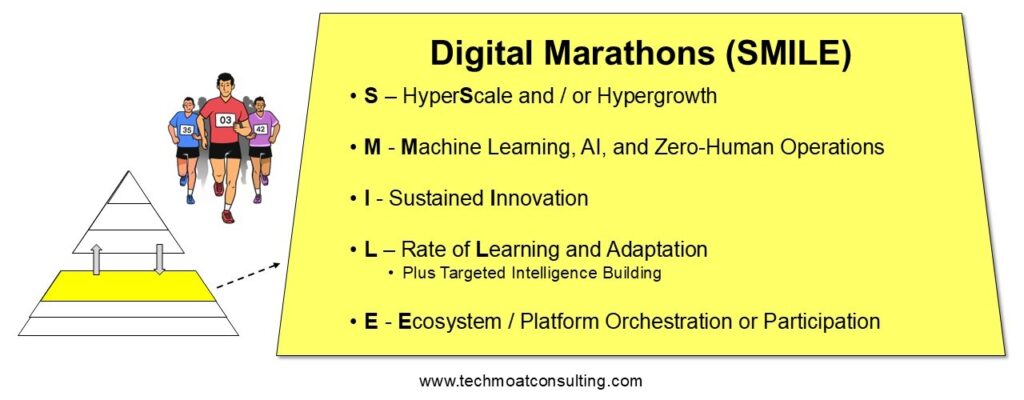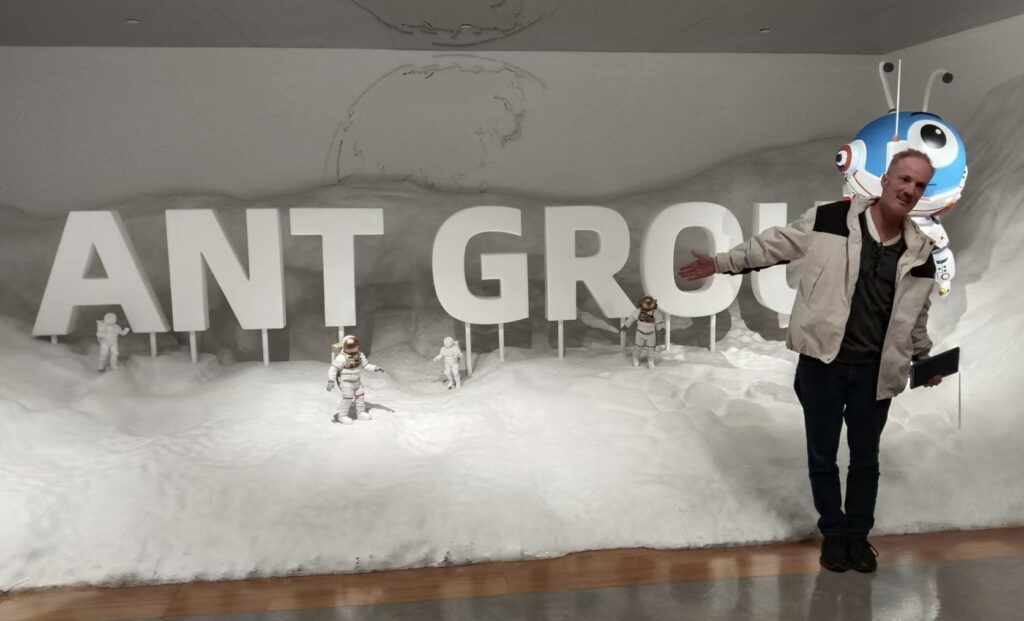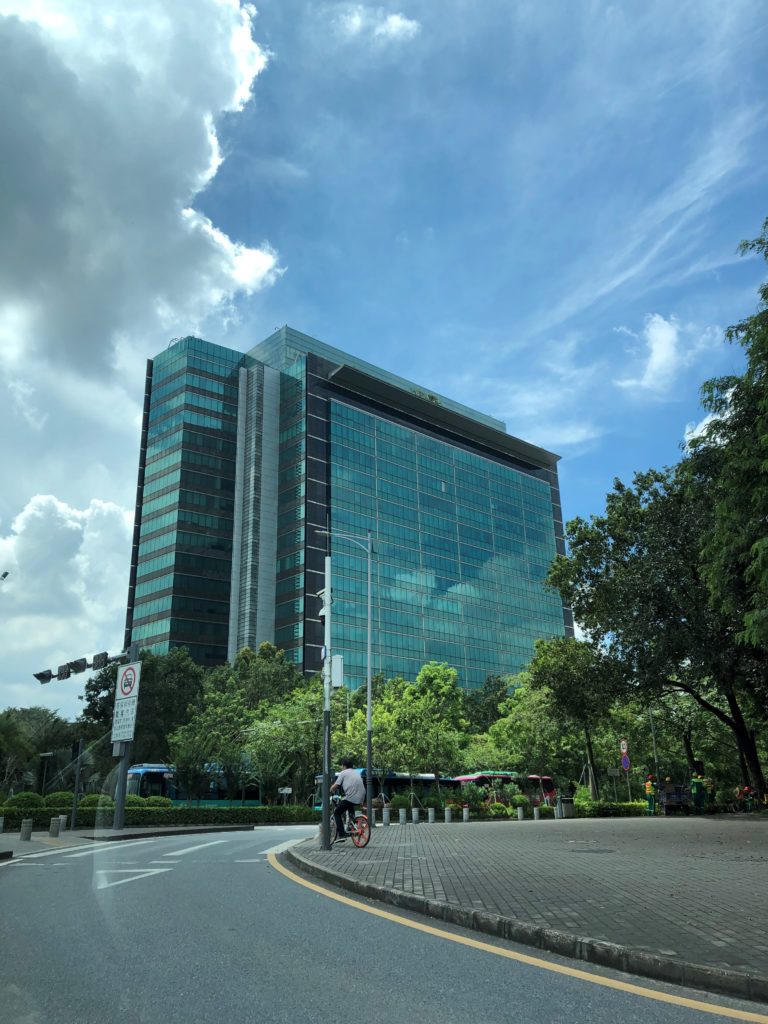Digital businesses operate in an increasingly fast-paced and dynamic environment. It’s just a more brutal playing field.
And distribution between winners and losers is getting more extreme.
And for those that do win, success is less permanent than before.
The only real solution is to constantly increase your customer value and to build a moat. Keep adding value to customers. And keep limiting exposure to competitors.
–
But the traditional competitive strategies often fall short. Moats are important of course. But they are often not enough. Speed also matters. You need to both build moats and run marathons. Which is why my books are called Moats and Marathons.
Companies must run what I call “digital marathons”. This is about choosing specific operational activities where you can achieve superior operating performance over time. The analogy is that these activities are races where you want to slowly pull away from other companies over time. You want to open up the distance from the pack in the marathon. And, maybe, at a certain point you pull so far ahead, it becomes a sustainable operating advantage. But this happens over the long-term. It’s a marathon, not a sprint.

Basically:
- Moats are about building structural advantages. Both barriers to entry and competitive advantages.
- Marathons are about creating operating advantages. In a specific activity.

In my books, I cite 5 types of digital marathons, encapsulated by the SMILE acronym:
- Hyperscale and/or Hypergrowth (S)
- Machine Learning/AI/Zero-Human Operations (M)
- Sustained Innovation (I)
- Rate of Learning and Adaptation (L)
- Ecosystem/Platform Orchestration or Participation (E)
These are activities where a consistent, long-term effort can create significant competitive separation. There can certainly be other activities like this. These five are just the ones I see frequently in digital businesses.

That said, here are some things to keep in mind about choosing and running a digital marathon.
1: Digital Marathons Are Different than Temporary Advantages in Tactics or Digital Operating Basics
A common misconception is that simply being good at daily digital operations (responding quickly to market changes) is an operating advantage. It can often appear this way in the short term. Especially for a first mover.
But I put this under Tactics and Digital Operating Basics. Being good at digital operating activities is just table stakes in a digital business. And any temporary advantages here usually get copied.
So, keep in mind:
- Tactics and digital operating basics are 100% necessary for both survival and competitive performance.
- But they are typically not sufficient to create sustainable competitive strength or to differentiate a company from the pack over the longer-term.
I view these types of tactics and operational performance as running in a sea of people in a marathon.

Basically, everyone is doing roughly the same activities. To win, you need to do different things. Or you need to choose a particular activity and pull away from the pack over time. That means a business needs to choose 1-2 key operational activities to focus on over a long period. And you need to commit capital and resources in this area, even if you don’t see any immediate results.
Choosing a marathon (and a moat) is a top-down strategic decision by senior management. You need to build an operating advantage in an activity that makes a difference.
2: You Always Go for Growth and Scale Advantages in Digital (S). But Traditional Scale Disadvantages Can Still Apply to Digital.
The S is SMILE stands for “Hyperscale and/or Hypergrowth”. And it’s first on the list. Because going for growth and scale is still the default business strategy. In fact, in digital, growth and scale are even more important. Digital businesses can grow and scale at rates that traditional businesses can only dream of. There is really no point in being a digital business if you are not going for scale.
In the traditional industrial businesses, you grow by increasing physical assets and human labor. This creates lots of advantages but takes time. And it always leads to diminishing returns due to increasing complexity and bureaucracy (i.e., the disadvantages of scale).
But digital economics are different. They are really good for growth and scale.
- Digital goods often have zero marginal reproduction costs (e.g., copying a file is free).
- They can be non-rival (many users can use them simultaneously).
- They are not really limited by production capacity. Software can be used endlessly.
These powerful economics allow for dramatically faster, cheaper, and often unconstrained growth. YouTube is global. So is Google Search. So is TikTok.
It gets better.
Digital businesses often don’t have the traditional disadvantages of scale.
Software and AI can handle immense complexity and connectivity without suffering from bureaucracy or unwieldy operational scope.
For example, at IPO Ant Group’s core operations were based on a 3-1-0 model, which stood for 3 minutes for a loan application, 1 second for approval, and 0 humans involved. This zero-human approach allowed them to do things no physical bank could ever do. They could theoretically process 10 million loans a day as easily as they did 100. They could theoretically offer 100,000 financial services products as easily as they did 100. Ant is aiming for a future with all the advantages of scale but none of the disadvantages. In fact, the system will probably get smarter and smarter with scale.

ByteDance’s TikTok, being an AI product at its core, is similar. It can match strange, specific sub-types of content with strange, specific sub-types of user interests at an unprecedented scale. One, this makes it highly addictive. Two, it doesn’t have the human limitations of traditional media companies at large scale.
3: Sustained Innovation (I) is a Common Marathon in Tech. But Innovation in What?
Innovation is often seen as a universal business virtue. But not all innovation, even in digital businesses, is the same. There is a big difference in innovating in CPG products and rocket ships.
So, what qualifies as a “sustained innovation” marathon that can create long-term competitive strength?
I often talk about data-driven, customer-focused innovation. In fact, I explicitly listed this as a “Digital Operating Basic” that almost every company must perform constantly. But that is table stakes in the age of abundance. It is rarely a sustainable operating advantage.
For innovation to become a digital marathon, it needs to be focused, longer-term, and with a cumulative effect.
The “cumulative” part is pretty rare. Most tech-based innovation becomes obsolete pretty fast.
Huawei serves as a powerful example. For its first two decades, it focused relentlessly on cost innovation. Basically, it was manufacturing telecom equipment cheaper than its mostly Western competitors. It was a fast follower in that it was copying technology by leaders like Ericsson. But it was innovating on the cost of these products (i.e., cost innovation).
Cost innovation is powerful.
For decades, Huawei invested typically 15% of its revenue into research and development. Mostly related to telco products and its manufacturing processes. And by 2012, after 25 years of this strategy, Huawei finally surpassed Ericsson as the global market leader in telco equipment.
Now as the global telecommunications leader, Huawei continued its relentless R&D spending. reaching nearly $20 billion in 2020. But it was not longer a fast follower. It was the leader.
So, during this period Huawei shifted towards engineering and pioneering new technologies. They had copied 4G but were a leading developer of 5G. And now of 5.5G.
When I think about sustained innovation, I think about companies like Huawei. It has been a there decade commitment in time, money and resources to steady, incremental innovation in what matters most. And it paid off.
It also includes people.
Huawei’s multi-decade commitment to tech innovation is deeply embedded in its culture. And in its HR policies. Its employee stock ownership plan (ESOP) aggressively measures and incentivizes long-term value contribution.

Final Point. Maybe the biggest threat to sustained innovation (and any marathon) is winning.
By 2020, Huawei had pulled way ahead of its competitors in telco (Ericsson, Nokia). And founder Ren Zhengfei openly worried that they would lose their edge without a strong competitor to fight against. Fortunately, the US government then launched an attack on the company, which re-ignited their competitive spirits. And they went back into battle mode. Which has really worked out well.
4: Rate of Learning and Adaptation (L) Is Becoming a Very Important Digital Marathon
Rate of learning and the resulting ability to adapt has long been important in areas like fashion and media. It’s a good strategic approach to businesses with uncertain and/or constantly changing customer preferences.
But I usually don’t consider it a digital marathon. However, that has been changing recently.
Machine learning is all about learning. And this is going into everything in business. Products, processes and increasingly organizations can be rapid learners. And increasingly, we are seeing learning and intelligence as a capability.
- For products, we can think about robotaxis. They learn the roads and drive themselves.
- For services, we can think robots in restaurants.
- For processes, we can think about adaptive marketing.
- For organizations, we can think about thinks like holocracy and Teal organizations.
But when is learning and adaptation a digital marathon?
I look for a business that is:
- Continually improving its ability to gather data, analyze it, and make decisions
- And is doing so faster, more frequency, and more effectively than its competitors.
- And doing so in key activities that matter in the business.
You need a long runway where you can keep staying ahead of rivals in your ability to learn and adapt. Right now, that looks to me like:
- Machine Learning in things like driving and industrial robots.
- Experimentation resources and capabilities.
Chinese direct-to-consumer apparel retailer Shein is often described as the pioneer of ultra-fast fashion. They reportedly launch over 5,000 new products every day (unclear), based on real-time measurements of changing customer preferences.
If true, this is an extreme rate of learning for retail, often described as “learning at the speed of algorithms”. Shein has definitely stunned competitors like Zara and H&M, who were the pioneers of “fast fashion”. Shein is making them appear really slow.
But I’m not convinced this is a digital marathon. I think Shein was just a first mover. And Temu and others have now copied their ultra-fast fashion model. As mentioned before, first movers can often be mistaken for having a sustainable operating advantage.
Alibaba’s Tmall Innovation Center (TMIC) is another example to consider. It enables brands like Milkana and Nestle to scour Alibaba’s vast consumer data for new product ideas, test them in real-time by selling them on Taobao, and then launch them. That’s how they launched spicy snickers and Nestle black coffee for the gym.
And TMIC can help merchants and brands do this in as little as 2-3 months. Compare that to typical product development of 12-18 months. I think Alibaba actually has a sustainable operating advantage in rate of learning and adaptation. But not the merchants using this service.
5: Ecosystem / Platform Participation (E) Is Usually Just the Digital Operating Basics
Most all digital businesses have to participate in platform ecosystems. Google Search. Amazon Marketplaces. Facebook marketing. And so on.
We really have no choice. Which sucks.
In the digital age, businesses are participants in interconnected ecosystems, which unfortunately are controlled by a small number of dominant firms.
Millions of businesses, especially SMEs, are now selling through centralized marketplaces, doing digital marketing on centralized social media, and managing customer relationships on centralized messaging apps. Effective platform participation is the key operating activity now.
So, when does this become a digital marathon?
Well, Ecosystem / Platform Orchestration or Participation (E) refers to two distinct digital marathons.
A business like Amazon is running a digital marathon in improving its management and orchestration of its own proprietary platform. That is really their primary operating activity. And staying ahead of rival platforms is key in this. For example, Alibaba is currently racing as fast as it can to stay ahead of Pinduoduo in platform orchestration.
The other digital marathon is improving one’s participation in a platform, as mentioned. This is rarely an operating advantage long term. Although it is often mistake for one.
An example of this is online beauty product company Perfect Diary, which experienced stunning growth by being an early participant in China’s social networks and influencer ecosystems. It got to Tmall, WeChat, Douyin and KOLs early and was exceptionally good at participating and scaling up. Within a few years of launch, it surpassed L’Oréal in sales online in China.
However, Perfect Diary’s abilities were quickly matched by other companies and it declined. Basically, it grew fast, went public and then got copied. Plus, the platform companies kept changing the rules for participants.
A good counter example is Viya, who was long China’s top influencer. She achieved tremendous success by selling goods on Taobao Live and was an early mover and effective ecosystem participant. And then, in a smart move, she partnered with the ecosystem orchestrator (i.e., Taobao Live). She effectively locked in her operating advantage as an ecosystem participant. That was smart. The most lasting competitive strength for an ecosystem participant is to create a strategic partnership with the orchestrator. That’s amazing if you can pull it off.

***
Ok. That is it for today. I hope that helped.
Cheers, Jeff
———-
Related articles:
- Lessons from My Visit to Alibaba Cloud (Tech Strategy – Podcast 244)
- AutoGPT: The Rise of Digital Agents and Non-Human Platforms & Business Models (Tech Strategy – Podcast 163)
- Why ChatGPT and Generative AI Are a Mortal Threat to Disney, Netflix and Most Hollywood Studios (Tech Strategy – Podcast 150)
From the Concept Library, concepts for this article are:
- Digital SMILE Marathons
From the Company Library, companies for this article are:
- n/a
———
I am a consultant and keynote speaker on how to accelerate growth with improving customer experiences (CX) and digital moats.
I am a partner at TechMoat Consulting, a consulting firm specialized in how to increase growth with improved customer experiences (CX), personalization and other types of customer value. Get in touch here.
I am also author of the Moats and Marathons book series, a framework for building and measuring competitive advantages in digital businesses.
This content (articles, podcasts, website info) is not investment, legal or tax advice. The information and opinions from me and any guests may be incorrect. The numbers and information may be wrong. The views expressed may no longer be relevant or accurate. This is not investment advice. Investing is risky. Do your own research.
